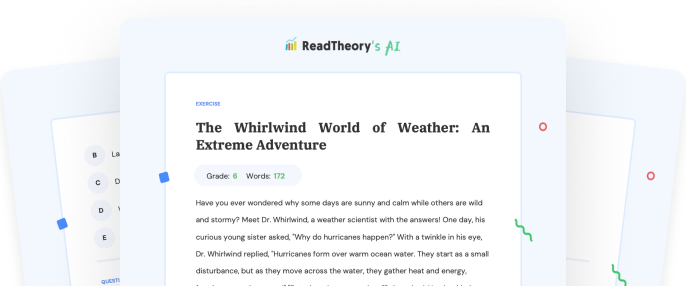Transform Your Teaching
with AI-Powered Worksheets
With ReadTheory’s Instant Worksheet Builder, you can create engaging, grade-appropriate worksheets tailored to your students in minutes. Spark curiosity, save time, and empower critical thinking with AI-powered tools designed for teachers like you.


Seals of the Arctic: Survivors of the Ice
In the heart of the frigid Arctic region, seals slide across the ice and dive into the icy waters. Creatures like the Ringed Seal, Bearded Seal, and Harp Seal call this icy wilderness home. These seals have developed remarkable adaptations to survive, boasting a thick layer of blubber for insulation and sleek bodies for agile swimming. Their diet mainly consists of fish and invertebrates, however, danger lurks as Polar Bears, one of their main predators, are always on the prowl. Despite this, seals play a crucial role in maintaining the balance of the Arctic ecosystem. Seals also hold significant cultural and subsistence value for the indigenous people, who have hunted them sustainably for centuries. However, the seals' existence is threatened by climate change, causing ice to melt and hunting grounds to shrink. It's crucial to understand and protect these fascinating Arctic inhabitants, as the health of the seals directly impacts the Arctic ecosystem and the people who rely on it.
Question 1
What adaptations have seals developed to survive in the Arctic region?
Thick layer of blubber for insulation and sleek bodies for agile swimming
Long legs for running on the ice
Wings for flying over the ice
Ability to breathe underwater
None of the above
Question 2
What is the primary diet of the seals in the Arctic?
Plants and grass
Birds and insects
Fish and invertebrates
Other seals
They are herbivores
Question 3
Who are the main predators of the seals in the Arctic region?
Penguins
Polar Bears
Whales
Sharks
Humans
Question 4
How does climate change threaten the existence of seals in the Arctic?
By causing ice to melt and hunting grounds to shrink
By causing the ocean's temperature to rise
By causing the fish population to decrease
By causing polar bears to increase
None of the above
Question 5
Why is it important to protect seals in Arctic region?
Because they are cute
Because they are endangered
Because the health of the seals directly impacts the Arctic ecosystem and the people who rely on it
Because they are the primary food source for polar bears
None of the above
 or share via
or share via

Assign the ReadTheory pretest to determine students' reading levels.

Why Teachers Love
Instant Worksheet Builder?

Tailored Content for Every Student
Craft worksheets with passages and multiple-choice questions customized to your chosen topic and grade level, ensuring relevance and engagement.

Save Hours
of Prep Time
Our AI, Lexi, generates complete worksheets—passages, questions, and answers—in minutes, freeing you to focus on teaching, not planning.

Standards-Aligned Learning
Every worksheet is designed to boost reading comprehension and critical thinking, aligning seamlessly with State Standards to help your students shine.
Personalized teaching
for personalized learning
Browse worksheets created and refined by educators using Lexi—your source for inspiration and ready-to-use resources.


ReadTheory is free for Teachers to use.
Join thousands of educators using ReadTheory for free. Sign up today and start creating in just minutes!





